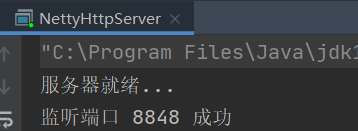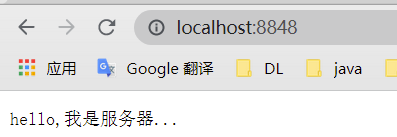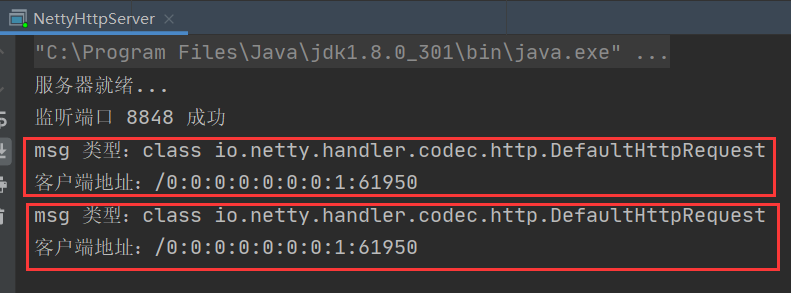1 案例需求分析
- Netty 服务器在 6668 端口监听,浏览器发出请求
http://localhost:6668/; - 服务器可以回复消息给客户端
Hello! 我是服务器,并对特定请求资源进行过滤; - 目的:了解如何使用Netty做HTTP服务开发,并且理解 Handler 实例和客户端及其请求的关系。
2 代码实现
2.1 总体思路
代码总体实现思路说明
- 步骤一:创建两个线程组 BossGroup 和 WorkerGroup,他们的类型都是 NioEventLoopGroup。bossGroup 只处理连接请求,workerGroup 处理客户端业务。
- 步骤二:创建服务器端启动对象 ServerBootstrap ,并进行参数配置:
- 设置 BossGroup 和 WorkerGroup
- 设置使用使用 NioSocketChannel 作为服务器的通道实现
- 设置保持活动连接
- 创建一个 通道(pipline) 测试对象(匿名对象),并为 pipline设置一个 Handler
- 步骤三:绑定端口并且同步,启动服务器,生成并返回一个 ChannelFuture 对象
- 步骤四:设置对关闭通道事件进行监听
public class NettyHttpServer {
public static void main(String[] args) {
EventLoopGroup bossGroup = new NioEventLoopGroup(1);
EventLoopGroup workerGroup = new NioEventLoopGroup(8);
try {
// 2.创建服务器端启动对象,配置参数
ServerBootstrap bootstrap = new ServerBootstrap();
// 使用链式编程进行设置
bootstrap.group(bossGroup,workerGroup)// 设置两个线程组
.channel(NioServerSocketChannel.class)// 使用 NioSocketChannel 作为服务器的通道实现
.option(ChannelOption.SO_BACKLOG,128)// 设置线程队列得到连接个数
.childOption(ChannelOption.SO_KEEPALIVE,true)// 设置保持活动连接
// 给 WorkerGroup 的 EventLoop 对应的 管道 设置 Handler
.childHandler(new NettyHttpServerInitializer());
System.out.println("服务器就绪...");
// 3.绑定端口并且同步,生成一个 ChannelFuture 对象
ChannelFuture cf = bootstrap.bind(8848).sync();
// 给 cf 注册监听器,监控我们关心的事件
cf.addListener(new ChannelFutureListener() {
@Override
public void operationComplete(ChannelFuture channelFuture) throws Exception {
if (cf.isSuccess()) {
System.out.println("监听端口 8848 成功");
} else {
System.out.println("监听端口 8848 失败");
}
}
});
// 4.对关闭通道事件进行监听
cf.channel().closeFuture().sync();
} catch (Exception e) {
e.printStackTrace();
} finally {
bossGroup.shutdownGracefully();
workerGroup.shutdownGracefully();
}
}
}
在上面的代码中我们将为pipline绑定Handler的代码逻辑抽取成一个类:
public class NettyHttpServerInitializer extends ChannelInitializer<SocketChannel> {
@Override
protected void initChannel(SocketChannel ch) throws Exception {
// 向 pipline 加入 Handler
ChannelPipeline pipeline = ch.pipeline();
// 加入一个 netty 提供的 httpServerCodec
// httpServerCodec:netty 提供的http编解码器
pipeline.addLast("MyHttpServerCodec",new HttpServerCodec());
// 增加一个自定义Handler
pipeline.addLast("MyNettyHttpServerHandler",new NettyHttpServerHandler());
}
}
上面这种写法和下面的写法是一样的
bootstrap.group(bossGroup,workerGroup)// 设置两个线程组
.channel(NioServerSocketChannel.class)// 使用 NioSocketChannel 作为服务器的通道实现
.option(ChannelOption.SO_BACKLOG,128)// 设置线程队列得到连接个数
.childOption(ChannelOption.SO_KEEPALIVE,true)// 设置保持活动连接
// 给 WorkerGroup 的 EventLoop 对应的 管道 设置处理器
.childHandler(new ChannelInitializer<SocketChannel>() {
// 创建一个通道测试对象(匿名对象)
// 向 pipline 设置 处理器
@Override
protected void initChannel(SocketChannel socketChannel) throws Exception {
// 向 pipline 加入 Handler
ChannelPipeline pipeline = ch.pipeline();
// 加入一个 netty 提供的 httpServerCodec
// httpServerCodec:netty 提供的http编解码器
pipeline.addLast("MyHttpServerCodec",new HttpServerCodec());
// 增加一个自定义Handler
pipeline.addLast("MyNettyHttpServerHandler",new NettyHttpServerHandler());
}
});
这里我们为pipline绑定了两个Handler:
- httpServerCodec:netty 提供的http编解码器;
- NettyHttpServerHandler:我们自己实现的Handler,用于接收和响应Http请求
NettyHttpServerHandler实现逻辑
它的主要逻辑就是接收客户端发来的请求,然后将信心封装为HttpRespose,返回给客户端。
/*
1.SimpleChannelInboundHandler是ChannelInboundHandlerAdapter的子类
2.HttpObject表示客户端和服务器端相互通讯的数据被封装成 HttpObject 类型
*/
public class NettyHttpServerHandler extends SimpleChannelInboundHandler<HttpObject> {
// 读取客户端数据
@Override
protected void channelRead0(ChannelHandlerContext ctx, HttpObject msg) throws Exception {
// 判断 msg 是不是 httprequest 请求
if (msg instanceof HttpRequest) {
System.out.println("msg 类型:"+msg.getClass());
System.out.println("客户端地址:"+ctx.channel().remoteAddress());
// 给浏览器回复信息 [http协议]
ByteBuf content = Unpooled.copiedBuffer("hello,我是服务器...", CharsetUtil.UTF_16);
// 构造http响应,httpresponse
DefaultHttpResponse httpResponse = new DefaultFullHttpResponse(HttpVersion.HTTP_1_1, HttpResponseStatus.OK, content);
httpResponse.headers().set(HttpHeaderNames.CONTENT_TYPE,"text/plaini");
httpResponse.headers().set(HttpHeaderNames.CONTENT_LENGTH,content.readableBytes());
// 发送构建好的 response
ctx.writeAndFlush(httpResponse);
}
}
}
2.2 测试结果问题分析
- 首先启动程序

- 浏览器发送请求:
http://localhost:8848/

- 查看控制台打印结果,我们发现服务端接收到了两次请求

问题分析
我们打开浏览器控制台发现,其实浏览器发送了两次请求,因此我们需要对特定请求资源进行过滤

2.3 问题解决:对特定请求资源进行过滤
我们只需要对 http://localhost:8848/favicon.ico 请求进行过滤即可。
/*
1.SimpleChannelInboundHandler是ChannelInboundHandlerAdapter的子类
2.HttpObject表示客户端和服务器端相互通讯的数据被封装成 HttpObject 类型
*/
public class NettyHttpServerHandler extends SimpleChannelInboundHandler<HttpObject> {
// 读取客户端数据
@Override
protected void channelRead0(ChannelHandlerContext ctx, HttpObject msg) throws Exception {
// 判断 msg 是不是 httprequest 请求
if (msg instanceof HttpRequest) {
System.out.println("msg 类型:"+msg.getClass());
System.out.println("客户端地址:"+ctx.channel().remoteAddress());
// 获取 httprequest
HttpRequest httpRequest = (HttpRequest) msg;
// 获取 uri
URI uri = new URI(httpRequest.uri());
// 判断
if ("/favicon.ico".equals(uri.getPath())) {
System.out.println("不做响应...");
return;
}
// 给浏览器回复信息 [http协议]
ByteBuf content = Unpooled.copiedBuffer("hello,我是服务器...", CharsetUtil.UTF_16);
// 构造http响应,httpresponse
DefaultHttpResponse httpResponse = new DefaultFullHttpResponse(HttpVersion.HTTP_1_1, HttpResponseStatus.OK, content);
httpResponse.headers().set(HttpHeaderNames.CONTENT_TYPE,"text/plaini");
httpResponse.headers().set(HttpHeaderNames.CONTENT_LENGTH,content.readableBytes());
// 发送构建好的 response
ctx.writeAndFlush(httpResponse);
}
}
}